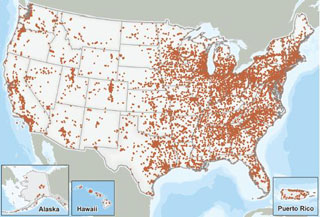You are here:
Learn about the Toxics Release Inventory
On This Page:
- What is the Toxics Release Inventory?
- Why was the TRI Program created?
- How is TRI different than other regulatory programs?
- Is TRI a mandatory program?
- What are TRI toxic chemicals?
- What types of industries are included in TRI?
- How does TRI relate to other EPA programs?
- TRI Overlap for Air, Water, and Waste Programs at EPA
What is the Toxics Release Inventory?
TRI tracks the management of certain toxic chemicals that may pose a threat to human health and the environment. U.S. facilities in different industry sectors must report annually how much of each chemical is released to the environment and/or managed through recycling, energy recovery and treatment. (A "release" of a chemical means that it is emitted to the air or water, or placed in some type of land disposal.)
The information submitted by facilities is compiled in the Toxics Release Inventory. TRI helps support informed decision-making by industry, government, non-governmental organizations and the public.
Why was the TRI Program created?
The TRI Program was created in response to several events that raised public concern about local preparedness for chemical emergencies and the availability of information on hazardous substances.
On December 4, 1984, a cloud of extremely toxic methyl isocyanate gas escaped from a Union Carbide Chemical plant in Bhopal, India. Thousands of people died that night in what is widely considered to be the worst industrial disaster in history. Thousands more died later as a result of their exposure, and survivors continue to suffer with permanent disabilities. In 1985, a serious chemical release occurred at a similar plant in West Virginia.
In 1986, Congress passed the Emergency Planning and Community Right-to-Know Act (EPCRA) to support and promote emergency planning and to provide the public with information about releases of toxic chemicals in their community. Section 313 of EPCRA established the Toxics Release Inventory.
How is TRI different than other regulatory programs?
In 1986, TRI was part of a new approach to environmental protection. By making information about industrial management of toxic chemicals available to the public, TRI creates a strong incentive for companies to improve environmental performance. Information disclosure programs such as TRI are different than most federal environmental programs that are designed to achieve better environmental performance by setting standards and specifying how facilities must operate. TRI is also different because the information is updated annually and is reported to EPA directly from facilities.
Is TRI a mandatory program?
TRI is a mandatory program. See the TRI Compliance and Enforcement webpage for more information.
What are TRI toxic chemicals?
In general, chemicals covered by the TRI Program are those that cause:
- Cancer or other chronic human health effects
- Significant adverse acute human health effects
- Significant adverse environmental effects
There are currently over 650 chemicals covered by the TRI Program. Facilities that manufacture, process or otherwise use these chemicals in amounts above established levels must submit annual TRI reports on each chemical. The TRI chemical list doesn't include all toxic chemicals used in the U.S.

What types of industries are included in TRI?
Facilities that report to TRI are typically larger facilities involved in manufacturing, metal mining, electric power generation, chemical manufacturing and hazardous waste treatment. Not all industry sectors are covered by the TRI Program, and not all facilities in covered sectors are required to report to TRI. See the Basics of TRI Reporting for more information.
How does TRI relate to other EPA programs?
A number of EPA programs collect chemical release and waste management information. Each of these programs has different requirements for who must report, what information must be reported and how often they must report. There is, however, some overlap between the facilities regulated by these programs and the facilities that report to TRI.
Users who want to find information that is not available in TRI can check the databases associated with these other programs. For example, the National Emissions Inventory (NEI) can be used to find estimates of air releases for facilities that do not report to TRI or for mobile sources such as cars, which are not covered by TRI. These databases include:
- RCRA Info – contains hazardous waste management information;
- PCS and ICIS-NPDES – contains monthly measurements of chemicals released to water at facilities with discharge permits;
- National Emissions Inventory (NEI) – contains air release estimates for stationary and mobile sources;
- Risk Management Plan (RMP) – contains risk management plans that state the amount of chemicals facilities have in on-site processes.
TRI Overlap for Air, Water, and Waste Programs at EPA

For an explanation of this diagram and more information about the relationship between TRI and other EPA programs, please see pages 7-9 of Factors to Consider When Using TRI Data (PDF), available in English and Spanish.

